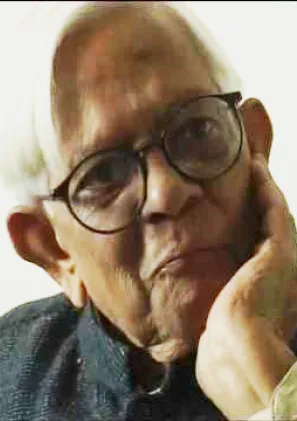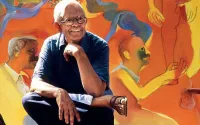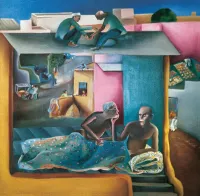Biography
1934 - 2003
Bhupen Khakhar was born in Bombay, India on March 10, 1934. He was the first of his family to attend the University of Bombay where, at his parents’ insistence, he studied to be an accountant. By the time he turned 30 he had grown restless and dissatisfied. Against his family’s wishes, he decided to enroll in the School of Art in Baroda. He first exhibited in India in 1963 and had his first solo show in 1965. Khakhar garnered attention and critical praise for his work meticulously reproducing the look and feel of Indian markets and temples as a vivid and colorful celebration of the everyday struggles of India's common man. By 1967 he was proclaimed India's first Pop artist. In 1979 he went to London to teach for several months, where he met artists Howard Hodgkin and David Hockney, both of whom began to influence his art. By the 1980s Khakhar was featured in solo shows worldwide. During this same period he stunned his countrymen by coming out as gay. Afterwards, his work began to depict homosexual love encounters from a distinctively Indian perspective. This sort of "coming out" was unprecedented in Indian culture and cast him as an iconoclast and maverick. His open homosexuality and exploration of homoerotic themes became controversial. The explicit imagery of some of his paintings challenged many curators and galleries. Khakhar became vocal regarding the personal and artistic rejection he felt after coming out; but nonetheless he continued to create. After this bold period, his work became more settled and, by the time he was in his 60s, he returned to the themes of everyday life in India that had first established his legacy. The man referred to as “possibly the most provocative painter in contemporary Indian art” died of cancer at age 69 on August 8, 2003 in Baroda, India. Khakhar’s work can be found in such collections as the British Museum, The Tate Gallery in London, and the Museum of Modern Art in New York. Yet, sadly, even today much of his heralded work is excluded from some galleries due to its homoerotic content.
1934 - 2003
Bhupen Khakhar was born in Bombay, India on March 10, 1934. He was the first of his family to attend the University of Bombay where, at his parents’ insistence, he studied to be an accountant. By the time he turned 30 he had grown restless and dissatisfied. Against his family’s wishes, he decided to enroll in the School of Art in Baroda. He first exhibited in India in 1963 and had his first solo show in 1965. Khakhar garnered attention and critical praise for his work meticulously reproducing the look and feel of Indian markets and temples as a vivid and colorful celebration of the everyday struggles of India's common man. By 1967 he was proclaimed India's first Pop artist. In 1979 he went to London to teach for several months, where he met artists Howard Hodgkin and David Hockney, both of whom began to influence his art. By the 1980s Khakhar was featured in solo shows worldwide. During this same period he stunned his countrymen by coming out as gay. Afterwards, his work began to depict homosexual love encounters from a distinctively Indian perspective. This sort of "coming out" was unprecedented in Indian culture and cast him as an iconoclast and maverick. His open homosexuality and exploration of homoerotic themes became controversial. The explicit imagery of some of his paintings challenged many curators and galleries. Khakhar became vocal regarding the personal and artistic rejection he felt after coming out; but nonetheless he continued to create. After this bold period, his work became more settled and, by the time he was in his 60s, he returned to the themes of everyday life in India that had first established his legacy. The man referred to as “possibly the most provocative painter in contemporary Indian art” died of cancer at age 69 on August 8, 2003 in Baroda, India. Khakhar’s work can be found in such collections as the British Museum, The Tate Gallery in London, and the Museum of Modern Art in New York. Yet, sadly, even today much of his heralded work is excluded from some galleries due to its homoerotic content.
Demography
Demography
Gender Male
Sexual Orientation Gay
Gender Identity Cisgender
Ethnicity Asian/Pacific Rim
Nations Affiliated India
Era/Epoch Information Age (1970-present)
Field(s) of Contribution
Art
Business
Commemorations & Honors
Bestowed the Padma Shri Indian Government's Award for Excellence (1984)
Asian Council's Starr Foundation Fellowship Winner (1986)
Prince Claus Awardee (2000)
Demography
Gender Male
Sexual Orientation Gay
Gender Identity Cisgender
Ethnicity Asian/Pacific Rim
Nations Affiliated India
Era/Epoch Information Age (1970-present)
Field(s) of Contribution
Art
Business
Commemorations & Honors
Bestowed the Padma Shri Indian Government's Award for Excellence (1984)
Asian Council's Starr Foundation Fellowship Winner (1986)
Prince Claus Awardee (2000)
Resources
Resources
Hyman, Timothy. Bhupen Khakhar. Bombay: Chemould Publications and Arts, 1998.
Hyman, Timothy. "The Baroda School and Bhupen Khakhar: New Figuration in India." Art International 10 (Spring1990): 60-64.
Sjoman, N. E. "Oriental Pink Lime, the Art of Bhupen Khakar." Border Crossings 17 (Winter 1998): 40-43.
http://www.tate.org.uk/art/artists/bhupen-khakhar-2406
http://bhupenkhakharcollection.com/biography/
https://bhupenkhakharcollection.com/gay-and-hearty/
Resources
Hyman, Timothy. Bhupen Khakhar. Bombay: Chemould Publications and Arts, 1998.
Hyman, Timothy. "The Baroda School and Bhupen Khakhar: New Figuration in India." Art International 10 (Spring1990): 60-64.
Sjoman, N. E. "Oriental Pink Lime, the Art of Bhupen Khakar." Border Crossings 17 (Winter 1998): 40-43.
http://www.tate.org.uk/art/artists/bhupen-khakhar-2406
http://bhupenkhakharcollection.com/biography/
https://bhupenkhakharcollection.com/gay-and-hearty/





